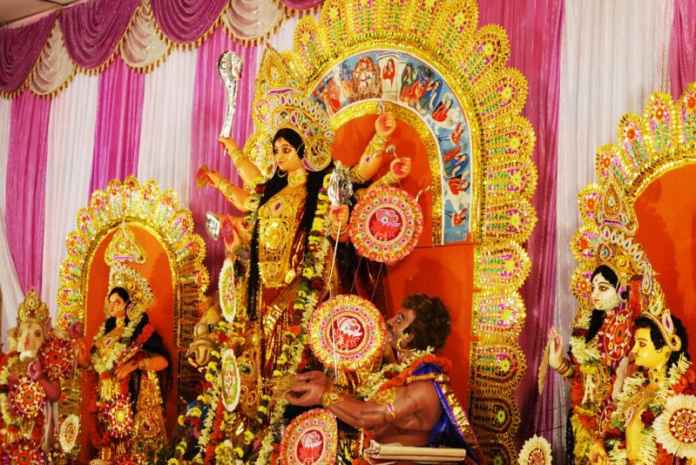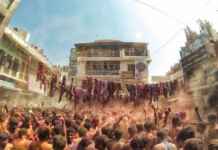In Indian culture and society, goddess Durga is represented carrying different weapons in her ten arms while riding on a lion. Thereby, she is an embodiment of feminine power in the Hindu scriptures. Thus, Durga Puja commemorates the victory of Goddess Durga over the buffalo demon Mahishasura. This annual celebration is spread over the last five days of Navaratri and Dussehra and is also an occasion for reunion and rejuvenation.
The origins of Durga Puja can be traced to the medieval period, when it was first celebrated, as per historical sources. It was during the 18th century, the worship of Durga became popular among the land aristrocrats of Bengal, locally known as the Zamindars. With ten days of fast, feast and worship, particularly the last four days namely- Saptami, Ashtami, Navami and Dashami – are celebrated with much gaiety and grandeur. In 2014, Durga Puja will take place from September 29-October 4. The immersion of Durga idols will happen on October 4, 2014.
The significant days of Durga Puja are as listed below:
• Mahalaya: Mahalaya heralds the advent of Goddess Durga through an invocation to Her to descend on Earth. On amavasya night, people pray to Goddess Durga to arrive on Earth to ward off all evils. On the dawn of
Mahalaya, homes in Bengal resonate with the immortal verses of the Chandipath.
• Mahashashthi: On this day, Goddess Durga arrives to the mortal world from her heavenly abode. Unveiling the face of the idol is the main ritual on this day.
• Mahasaptami: This is the first day of Durga Puja which involves an ancient ritual of worshiping nine types of plants.
• Mahaastami: Devotees offer anjali to the Goddess in the evening on this day.
• Mahanavami: This is the concluding day of Durga Puja. The main aarti is performed at the end of Sandhi Puja.
• Vijayadashmi: As the name suggests, this is the tenth and the last day, the day of ‘vijaya’ or victory. All the images are carried in processions and finally immersed in a nearby river. It is usually a tearful farewell.
Bengalis, for whom Durga Puja is a significant festival, eagerly await the ‘Pujos’. In fact, preparations for the festival are underway three to four months beforehand. Pandals are set up in almost every locality, each excelling in their display and exquisiteness of the Goddess Durga idol. Puja committees decide on a particular theme, whose elements are incorporated into the pandal and the idols. In fact, there also are competitions for the best decorated pandal. Food stalls serve delectable delicacies in these pandals. People get dressed in the evening and visit these pandals, also dubbed as ‘pandal hopping’.
Durga Puja is an extravagant and colourful celebration. In a way, it inaugurates the festive season in India as after Dussehra, Diwali follows. For those who want to enjoy the Durga Puja flavor, plan a trip to India around the month of October. Kolkata, Delhi are among the cities which will offer you a unique experience of Durga Puja. Start planning, now!










